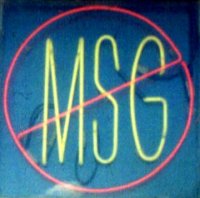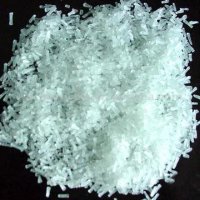MSG: If it's Safe, Why do They Disguise it on Labels?
by www.SixWise.com
Monosodium glutamate, commonly known as MSG, was thought
of as a "miracle food enhancer" when it was first
introduced to the public over five decades ago.
More than just a seasoning like salt and pepper, MSG could
actually enhance the flavors of foods, making processed meats
and frozen dinners taste fresher and smell better, salad dressings
more tasty, and canned foods less tinny.
|

This sign from the front window of a Chinese restaurant
suggests just how many people prefer to have their food
MSG-free.
|
It wasn't until people started having side effects after
eating foods with MSG that some began to question whether
this miracle flavoring was too good to be true. Today, many
more question its safety, but others insist it's safe.
How Much MSG are Americans Eating?
Americans associate MSG with Chinese food. In fact, MSG Symptom
Complex, which the Food and Drug Administration (FDA) identifies
as "short-term reactions" to MSG, was for some time
(unfairly) referred to in the United States as "Chinese
Restaurant Syndrome."
But MSG is in many more foods than Chinese food, and is listed
under many other names than MSG. So while many Americans are
aware that MSG has been linked to some negative side effects,
or have experienced them personally, and believe they are
avoiding it in their diets, many have been misled.
Food manufacturers, who realize that many people would prefer
NOT to have MSG in their food, have adapted by using so-called
"clean labels." These ingredient labels hide MSG
under names that consumers won't recognize, such as hydrolyzed
soy protein.
Some manufacturers have also gone so far as to list "No
MSG," "No Added MSG," or "No MSG Added"
on product labels when MSG is still present, but exists only
as a constituent in another ingredient!
|
MSG is Always In:
- Autolyzed yeast
- Calcium caseinate
- Gelatin
- Glutamate
- Glutamic acid
- Hydrolyzed protein
- Monopotassium glutamate
- Monosodium glutamate
- Sodium caseinate
- Textured protein
- Yeast extract
- Yeast food
- Yeast Nutrient
|
MSG is Often In:
- Barley Malt
- Bouillon
- Broth
- Carrageenan
- Enzyme-modified substances
- Flavoring
- Flavors
- Malt Extract
- Malt flavoring
- Maltodextrin
- Natural flavor/flavorings
- Natural pork/beef/chicken flavoring
- Pectin
- Protein-fortified substances
- Seasonings
- Soy protein
- Soy protein isolate or concentrate
- Soy sauce
- Soy sauce extract
- Stock
- Vegetable gum
- Whey protein
- Whey protein isolate or concentrate
|
What Does the Government Say?
The Federation of American Societies for Experimental Biology
(FASEB), a group of scientists the FDA asked to review the
safety of glutamate, released a report in 1995 that found
the following:
-
When consumed at usual levels, MSG is safe for the general
population.
-
No evidence of any connection between MSG and serious
long-term reactions.
-
No evidence linking dietary MSG or glutamate to Alzheimer's
disease, Huntington's disease, or any other long-term
or chronic diseases.
- No evidence suggesting that dietary MSG or glutamate causes
brain lesions or damage to nerve cells in humans.
However, the study did find that MSG Symptom Complex did
occur in some people, particularly those who ate a large dose
of MSG and those with severe asthma. According to the FDA,
MSG Symptom Complex can result in:
- Numbness
- Burning sensation
- Tingling
- Facial pressure or tightness
- Chest pain
- Headache
|
- Nausea
- Rapid heartbeat
- Drowsiness
- Weakness
- Difficulty breathing for asthmatics
|
Estimates of just how many Americans are sensitive to MSG
vary widely: from 1.8 percent to 50 percent of the population
may be affected. However, these estimates may be conservative.
Symptoms related to MSG may present immediately or several
hours after eating a food, so attributing them to MSG can
be difficult.
|

We've all eaten it, but now you can say you've seen
it: Here's what MSG looks like close-up.
|
In terms of labeling requirements, the FDA says that "monosodium
glutamate" must be listed on the label only if MSG is
added to a food. However, it's misleading for a manufacturer
to list "No MSG," or "No Added MSG" on
foods if sources of free glutamates, like hydrolyzed protein,
exist, they say. Further, items listed as "flavors,"
"natural flavors," or "flavorings" may
not include MSG, hydrolyzed proteins or autolyzed yeast.
The Other Side
Other experts are not so convinced of MSG's safety. For instance,
Dr. Russell Blaylock, an author and neurosurgeon, recently
explained a link between sudden cardiac death, particularly
in athletes, and excitotoxic damage caused by food additives
like MSG and artificial sweeteners. Excitotoxins are, according
to Dr. Blaylock, "A group of excitatory amino acids that
can cause sensitive neurons to die."
Said Dr. Blaylock:
"When an excess of food-borne excitotoxins, such as
MSG, hydrolyzed protein soy protein isolate and concentrate,
natural flavoring, sodium caseinate and aspartate from aspartame,
are consumed, these glutamate receptors are over-stimulated,
producing cardiac arrhythmias. When magnesium stores are
low, as we see in athletes, the glutamate receptors are
so sensitive that even low levels of these excitotoxins
can result in cardiac arrhythmias and death."
Further, many consumers have personally experienced the ill
effects of MSG, which leave them with a headache, nausea or
vomiting after eating MSG-containing foods.
Said Cathy Evans Wisner in her article "The MSG Myth,"
"I know from personal experience that the chemical is
not as harmless as vinegar or salt. When I ingest a fair amount
of MSG, I immediately have nausea, stomach cramps, "spaciness,"
heart palpitations and a "pins-and-needles" headache,
followed the next day by lethargy and overall weakness."
Headaches are one of the most commonly reported side effects
of MSG, which may occur because it can increase blood flow
to the brain. According to Ann Turner, director of the Migraine
Action Association, "Food additives can be triggers [for
headaches]. MSG, although still not fully understood, may
be a culprit ... "
Which Foods Contain MSG?
MSG is much more prevalent than many people realize. Below
is a list of some common food items that contain it from MSGTruth.org,
but remember to look for the "hidden" MSG names
(listed above) on all processed foods you buy.
-
The Following McDonald's Items:
-
Grilled Chicken Filet
-
Hot and Spicy Chicken Patty
-
Grilled Chicken Ceasar Salad
-
Grilled Chicken California Cobb Salad
-
Seasoned Beef
-
Sausage Scrambled Egg Mix, Sausage, and Sausage
Patty
-
Doritos®
-
Pringles® (the flavored varieties)
-
KFC® fried chicken and most of their other
products
-
Boar's Head® cold cuts and most of their hotdogs
-
Progresso® Soups
-
Lipton® Noodles and Sauce
-
Lipton® Instant soup mix
-
Gravy Master®
-
Cup-a-soup® or Cup-o-Noodles®
-
Planters® salted nuts (most of them)
-
Accent® (this "seasoning" is nearly
pure MSG)
-
Sausages (most supermarkets add MSG to theirs)
-
Processed cheese spread
-
Supermarket poultry or turkeys that are injected
or "self-basting"
-
Restaurant gravy from food service cans
-
Flavored ramen noodles
-
Boullion
-
Instant soup mixes
-
Many salad dressings
-
Most salty, powdered dry food mixes
-
Flavored potato chips
-
Gelatin
-
Canned tuna
-
Hot dogs
-
Soy sauce
-
Worcestershire sauce
-
Kombu extract
-
Dry milk
-
Dough conditioners
-
Body builder drink powders containing protein
-
Medications in gelcaps (contain free glutamic acid
in the gelatin)
-
Fresh produce that has been sprayed with Auxigro,
a plant growth enhancer that contains hydrolyzed
protein(s) and MSG (some of these crops may be used
in baby foods)
|
Your best bet as a consumer looking to avoid MSG, for whatever
your personal reasons may be, is to be diligent in reading
processed food labels.
In general, the more highly processed a food is (or the more
ingredients listed on its label), the more likely it is to
contain MSG. Meanwhile, try to limit the number of processed
foods you eat overall and you'll inevitably reduce your chances
of eating MSG, too.
Recommended Reading
Alcohol
Consumption--How Much is "Too Much" and "Too
Little?"
Why
Green Tea Would be Healthy EXCEPT for This One Dangerous Issue
Sources
EMediaWire
April 15, 2005
How
Food Could Help Your Headache April 18, 2005
MSG
Truth
The
MSG Myth: Why the Wonder "Spice" Isn't So Wonderful
Truth
in Labeling
U.S.
FDA MSG
Whole
Foods Market: MSG